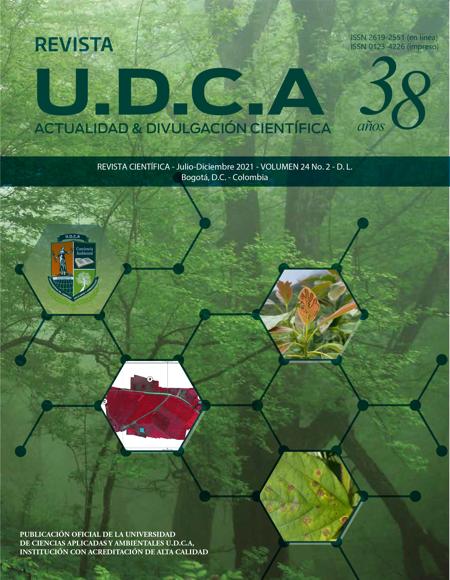Efecto de la fertilización orgánica y la poda sobre la producción de cacao en Cundinamarca, Colombia
Effect of organic fertilization and pruning on cacao yield in Cundinamarca, Colombia
Contenido principal del artículo
Resumen
El cultivo de cacao tiene una alta importancia social en Colombia, pero requiere la implementación de técnicas de cultivo que mejoren su productividad, principalmente, en la producción de cacao orgánico. La poda y los fertilizantes orgánicos fueron evaluados, como los tratamientos para incrementar el rendimiento de cacao, en una plantación antigua en el departamento Cundinamarca. La aplicación de fertilizantes orgánicos y la poda tuvieron efectos positivos sobre la morfometría del fruto y el rendimiento del cacao. La aplicación de fertilizantes orgánicos con poda, en general, aumentó la longitud y el diámetro de frutos de cacao. Se encontró una correlación negativa (R=-0,618) entre el contenido relativo de clorofila en hojas al final del período de cosecha y el número de frutos por árbol. Se obtuvo una correlación positiva (R=0,748) entre el peso fresco de frutos y el peso seco de semillas. No se estableció correlación entre el contenido relativo de clorofila en hojas y el peso seco de semillas. La poda más fertilización orgánica aumentó el peso seco total de semillas por árbol, en casi un 15 %, lo que convierte la poda con aplicación de fertilizante orgánicos en una herramienta para aumentar el rendimiento de cacao orgánico en antiguas plantaciones, en el departamento Cundinamarca.
Palabras clave:
Descargas
Datos de publicación
Perfil evaluadores/as N/D
Declaraciones de autoría
- Sociedad académica
- Universidad de Ciencias Aplicadas UDCA
- Editorial
- Universidad de Ciencias Aplicadas y Ambientales U.D.C.A
Detalles del artículo
Referencias (VER)
ACHEAMPONG, K.; HADLEY, P.; DAYMOND, A.J.; ADU-YEBOAH, P. 2015. The influence of shade and organic fertilizer treatments on the physiology and establishment of Theobroma cacao clones. American Journal of Experimental Agriculture. 6(6):347-360.
https://doi.org/10.9734/AJEA/2015/15206
ADEJOBI, K.B.; AGELE, S.; AIYELARI, O.P. 2019. Effects of organic amendments on growth, establishment, and yield of cacao (Theobroma cacao L) in Southwestern Nigeria. Asian Research Journal of Agriculture. 11(2):1–14.
https://doi.org/10.9734/ARJA/2019/V11I230052
ADEJOBI, K.B.; AGELE, S.O.; AIYELARI, P.O. 2017. Effects of organic manure on soil properties and health and growth performance of cacao (Theobroma cacao L) in Southwestern Nigeria. Journal of Global Biosciences. 6(4):4876-4895.
AGGANGAN, N.S.; CORTES, A.D.; REAÑO, C.E. 2019. Growth response of cacao (Theobroma cacao L.) plant as affected by bamboo biochar and arbuscular mycorrhizal fungi in sterilized and unsterilized soil. Biocatal Agric Biotech. 22:101347.
https://doi.org/10.1016/j.bcab.2019.101347
AGRONET. 2020. Reporte: Área, Producción y Rendimiento Nacional por Cultivo. Available from Internet in: https://www.agronet.gov.co/estadistica/Paginas/home.aspx?cod=1 (with access on 20/11/2020).
AGUDELO-CASTAÑEDA, G.A.; CADENA-TORRES, J.; ALMANZA-MERCHÁN, P.J.; PINZÓN-SANDOVAL, E.H. 2018. Desempeño fisiológico de nueve genotipos de cacao (Theobroma cacao L.) bajo la sombra de tres especies forestales en Santander, Colombia. Revista Colombiana Ciencias Hortícolas. 12(1):223-232.
https://doi.org/10.17584/rcch.2018v12i1.7341
ÁLVAREZ-CARRILLO, F.; ROJAS-MOLINA, J.; SUÁREZ-SALAZAR, J. 2015. Effect of organic and conventional fertilization on the growth and production of Theobroma cacao L. under an agroforestry system in Rivera (Huila, Colombia). Ciencia Tecnología Agropecuaria. 16(2):307-314.
https://doi.org/10.21930/rcta.vol16_num2_art:375
ANITA-SARI, I.A.; ZAKARIYYA, F.; SUSILO, A.W. 2015. Relationship between physiological characteristic and bean quality on some cocoa clones (Theobroma cacao L.). Pelita Perkebunan, Coffee and Cocoa Research Journal. 31(3):143-151.
http://dx.doi.org/10.22302/iccri.jur.pelitaperkebunan.v31i3.171
ARTHUR, A.; ACQUAYE, S.; DOGBATSE, J.A. 2019. Effect of some organic, inorganic and foliar fertilizers on the growth of cocoa (Theobroma cacao L.) seedlings raised in soils of contrasting characteristics. Greener Journal of Soil Science and Plant Nutrition. 6(1):08–14.
https://doi.org/10.15580/gjsspn.2019.1.061819111
BABIN, R. 2018. Pest management in organic cacao. In: Vacante, V.; Kreiter, S. (eds). Handbook of pest management in organic farming. Ed. CRC Press (New York). p.502-518.
BALAGUERA-LÓPEZ, H.E.; FISCHER, G.; MAGNITSKIY, S. 2020. Seed-fruit relationships in fleshy fruit species: Role of hormones. A review. Revista Colombiana de Ciencias Hortícolas. 14(1):90-103.
https://doi.org/10.17584/rcch.2020v14i1.10921
CELY TORRES, L.A. 2017. Oferta productiva del cacao colombiano en el posconflicto. Estrategias para el aprovechamiento de oportunidades comerciales en el marco del acuerdo comercial Colombia-Unión Europea. Equidad Desarrollo. 28:167-195.
https://doi.org/10.19052/ed.4211
CENTRE FOR THE PROMOTION OF IMPORTS FROM DEVELOPING COUNTRIES, CBI. 2020. Entering the European market for specialty cocoa. Available from Internet in: https://www.cbi.eu/market-information/cocoa-cocoa-products/specialty-cocoa/market-entry (with access on 20/11/2020).
CILAS, C.; MACHADO, R.; MOTAMAYOR, J.C. 2010. Relations between several traits linked to sexual plant reproduction in Theobroma cacao L.: number of ovules per ovary, number of seeds per pod, and seed weight. Tree Genetics Genomes. 6(2):219-226.
https://doi.org/10.1007/s11295-009-0242-9
DA SILVA ALMEIDA, R.L.; GARÓFALO CHAVES, L.H.; BONOMO, P.; DA SILVA ALMEIDA JUNIOR, R.L.; DANTAS FERNANDES, J. 2014. Produção do cacaueiro submetido a diferentes lâminas de irrigação e doses de nitrogênio. Revista Caatinga. 27(4):171-182.
DAYMOND, A.J.; HADLEY, P. 2008. Differential effects of temperature on fruit development and bean quality of contrasting genotypes of cacao (Theobroma cacao). Annals of Applied Biology. 153(2):175-185.
https://doi.org/10.1111/j.1744-7348.2008.00246.x
DIARIO OFICIAL DE LA UNIÓN EUROPEA. 2014. Reglamento UE de la Comisión No. 488 / 2014. Available from Internet in: https://www.boe.es/doue/2014/138/L00075-00079.pdf (with access on 07/02/2021).
ESCOBAR, S.; SANTANDER, M.; USECHE, P.; CONTRERAS, C.; RODRÍGUEZ, J. 2020. Aligning strategic objectives with research and development activities in a soft commodity sector: A technological plan for Colombian cocoa producers. Agriculture. 10(5):141.
https://doi.org/10.3390/agriculture10050141
FEDERACION NACIONAL DE CACAOTEROS, FEDECACAO. 2020. Economía. Available from Internet in: https://www.fedecacao.com.co/portal/index.php/es/2015-02-12-17-20-59/nacionales (with access on 22/10/2020).
FERNÁNDEZ LIZARAZO, L.; BOHORQUEZ SANTANA, W.; RODRIGUEZ VILLATE, A. 2016. Dinámica nutricional del cacao bajo diferentes tratamientos de fertilización con N, P y K en vivero. Revista Colombiana de Ciencias Hortícolas. 10(2):367-380.
https://doi.org/10.17584/rcch.2016v10i2.4702
FLORIDA, N.; LEVANO, J.; JACOBO, S.; FERRER, R. 2020. Physical-chemical indicators of soil and cocoa yield with organic and conventional management. Agroindust Sci. 10(2):175–180.
https://doi.org/10.17268/agroind.sci.2020.02.08
HOLDRIDGE, L.R. 1967. Life zone ecology. 1st ed. Tropical Science Center, San Jose, Costa Rica.
INSTITUTO COLOMBIANO AGROPECUARIO, ICA. 1992. Fertilización en diversos cultivos. Quinta aproximación. Manual Técnico No. 25. Centro de Investigación Tibaitata. Tibaitata, Colombia. 64p.
LACHENAUD, P. 1995. Variations in the number of beans per pod in Theobroma cacao L. in the Ivory Coast. III. Nutritional factors, cropping effects and the role of boron. Journal of Horticultural Science. 70(1):7-13.
https://doi.org/10.1080/14620316.1995.11515267
LOUREIRO, G.A.H.; ARAUJO, Q.R.; VALLE, R.R.; SODRÉ, G.A.; SANTOS FILHO, L.P.; OLIVEIRA, S.J.R.; DANTAS, P.A.S.; COUTO, R.L.; LOPES, M.R. 2016. Influence of environmental factors on cacao biometric attributes. Agrotrópica. 28(2):123-140.
http://dx.doi.org/10.21757/0103-3816.2016v28n2p123-140
MARROCOS, P.C.; LOUREIRO, G.A.D.; DE ARAUJO, Q.R.; SODRÉ, G.A.; AHNERT, D.; ESCALONA-VALDEZ, R.A.; BALIGAR, V.C. 2020. Mineral nutrition of cacao (Theobroma cacao L.): relationships between foliar concentrations of mineral nutrients and crop productivity. Journal of Plant Nutrition. 43(10):1498-1509.
https://doi.org/10.1080/01904167.2020.1739295
MEDAUAR, C.C.; GALVÃO, Í.M.; CARVALHO, L.C.; SILVA, S.D.A. 2018. Spatial-temporal variability of leaf chlorophyll and its relationship with cocoa yield. Revista Brasileira Engenharia Agrícola Ambiental. 22(3):164-169.
https://doi.org/10.1590/1807-1929/agriambi.v22n3p164-169
MONTAÑEZ, J.C.R.; CÓRDOBA, G.M.V.; HIGUERA, P.M. 2019. Oportunidades de las minicadenas productivas del sector cacao de Santander frente al posconflicto colombiano. Económicas CUC. 40(2):153-182.
https://doi.org/10.17981/econcuc.40.2.2019.10
NIETHER, W.; ARMENGOT, L.; ANDRES, C.; SCHNEIDER, M.; GEROLD, G. 2018. Shade trees and tree pruning alter throughfall and microclimate in cocoa (Theobroma cacao L.) production systems. Annals of Forest Science. 75(2):38.
https://doi.org/10.1007/s13595-018-0723-9
OSORIO-GUARÍN, J.A.; BERDUGO-CELY, J.; CORONADO, R.A.Z.; YENY, P.; QUINTERO, C.; GALLEGO-SÁNCHEZ, G.; YOCKTENG, R. 2017. Colombia a source of cacao genetic diversity as revealed by the population structure analysis of germplasm bank of Theobroma cacao L. Frontiers Plant Sci. 8:1994.
https://doi.org/10.3389/fpls.2017.01994
PILBEAM, D.J. 2015. Essential elements macronutrients. Nitrogen. In: Handbook of plant nutrition. CRC, NY. p.21-50.
PRODUCTORES AGROECOLOGICOS ASOCIADOS DE NILO, PROASOAGRO. 2020. Available from Internet in: https://www.proasoagro.com (with access on 22/10/2020).
RIEDEL, J.; KÄGI, N.; ARMENGOT, L.; SCHNEIDER, M. 2019. Effects of rehabilitation pruning and agroforestry on cacao tree development and yield in an older full-sun plantation. Experimental Agriculture. 55(6):849-865.
https://doi.org/10.1017/S0014479718000431
RODRÍGUEZ ALBARRCÍN, H.S.; DARGHAN CONTRERAS, A.E.; HENAO, M.C. 2019. Spatial regression modeling of soils with high cadmium content in a cocoa producing area of Central Colombia. Geoderma Regional. 16:e00214.
https://doi.org/10.1016/j.geodrs.2019.e00214
SANTOS, R.C.; PIRES, J.L.; CORREA, R.X. 2012. Morphological characterization of leaf, flower, fruit and seed traits among Brazilian Theobroma L. species. Genetic Resources and Crop Evolution. 59(3):327-345.
https://doi.org/10.1007/s10722-011-9685-6
SNOECK, D.; KOKO, L.; JOFFRE, J.; BASTIDE, P.; JAGORET, P. 2016. Cacao Nutrition and Fertilization. In: Lichtfouse, E. (eds) Sustainable Agriculture Reviews. Sustainable Agriculture Reviews, vol 19. Springer, Cham.
https://doi.org/10.1007/978-3-319-26777-7_4
SUGIYANTO, S.; BAKO, J.; ANOM WIJAVA, K. 2008. Soil chemical properties and nutrient uptake of cocoa as affected by application of different organic matters and phosphate fertilizers. Pelita Perkebunan, Coffee and Cocoa Research Journal. 24(3):188-204.
https://doi.org/10.22302/iccri.jur.pelitaperkebunan.v24i3.106
THONDAIMAN, V.; RAJAMANI, K. 2014. Correlation and path coefficient analysis of yield components in cocoa (Theobroma cacao L.). Journal of Plantation Crops. 42(3):358-363.
TUESTA-PINEDO, Á.L.; TRIGOZO-BARTRA, E.; CAYOTOPA-TORRES, J.J.; ARÉVALO-GARDINI, E.; ARÉVALO-HERNÁNDEZ, C.O.; ZÚÑIGA-CERNADEZ, L.B.; LEON-TTACCA, B. 2017. Optimization of organic and inorganic fertilization cocoa (Theobroma cacao L.) with the inclusion of Trichoderma endophyte and arbuscular mycorrhizae. Revista Tecnología Marcha. 30(1):67-78.
https://doi.org/10.18845/tm.v30i1.3086
VAN DER KNAAP, E.; ØSTERGAARD, L. 2018. Shaping a fruit: Developmental pathways that impact growth patterns. Seminars in Cell & Developmental Biology. 79:27-36.
https://doi.org/10.1016/j.semcdb.2017.10.028
VANHOVE, W.; VANHOUDT, N.; VAN DAMME, P. 2016. Effect of shade tree planting and soil management on rehabilitation success of a 22-year-old degraded cocoa (Theobroma cacao L.) plantation. Agricult Ecosyst Environm. 219:14-25.
https://doi.org/10.1016/j.agee.2015.12.005
ZAKARIYYA, F.; PRAWOTO, A. 2015. Stomatal conductance and chlorophyll characteristics and their relationship with yield of some cocoa clones under Tectona grandis, Leucaena sp., and Cassia surattensis. Pelita Perkebunan, Coffee and Cocoa Research Journal. 31(2):99-108.
https://doi.org/10.22302/iccri.jur.pelitaperkebunan.v31i2.165







